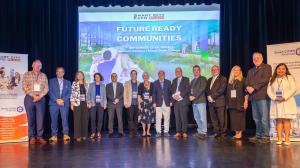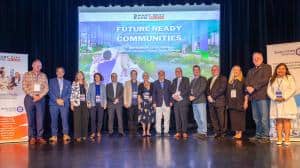
SCEM24 – Speakers
MIAMI, FL, UNITED STATES, September 26, 2024 /EINPresswire.com/ — The first day of the Smart City Expo Miami kicked off with a lively series of discussions under the banner of “Future Ready Communities,” bringing together urban planners, innovators, and thought leaders from around the globe. The event attracted a diverse, engaged crowd, eager to discuss the evolving challenges and opportunities that smart city initiatives present.
Bernardo Scheinkman, curator of the event, opened with enthusiasm, emphasizing the global reach of the expo and its role in sparking new ideas.
“There is nothing more powerful than bringing people together for meaningful experiences,” he said. “This year, we have the best speakers in the world sharing innovative content. The goal is to get people thinking outside the box.”
The Evolving Definition of Smart Cities The discussions throughout the day emphasized the shifting meaning of a “smart city.” Dr. Bruno Lanvin from the Smart City Observatory in Lausanne highlighted the importance of flexibility in defining success. “There’s more than one way to be smart,” he said. “The most successful cities integrate technology without making it too visible. It’s about using tech to solve real problems, not just showcasing it.” Lanvin also emphasized that human-centricity is key: “Our future is largely tied to cities, and the smartest cities will be those that focus on attracting and retaining talent while being inclusive and sustainable.”
Echoing this theme, Dr. Janice Perlman, founder of the Mega-Cities Project, underscored the importance of social cohesion and resilience in urban development. “The speed of disaster recovery is dependent on community cohesion and the strength of civil society,” she said, urging attendees to think about how cities can be designed to better withstand crises.
And Dr. Patricia McCarney, president and CEO of the World Council on City Data, presented her work on the need for standardizing data for cities.
Resilience and Climate Action
Resilience, both in terms of climate and community, was a major theme throughout the day. Alan Scott, Director of Sustainability at Intertek, spoke about the dual challenges of climate adaptation and mitigation. “We need to adapt to the climate we have now, while also reducing our emissions,” he said, highlighting how extreme weather events are becoming more frequent and severe. He called for stronger frameworks to assess and share climate risks, pointing to Miami’s flood barriers and energy storage initiatives as examples of proactive urban resilience.
Sarbeswar Praharaj of the University of Miami added that urban development needs to keep pace with changing realities, especially in areas like transportation and housing. “Land use, housing, and transport policies must evolve quickly to support growing urban populations. Smart cities are about understanding the data that exists and applying it to these urgent challenges,” he explained.
Tim Sperry from South Florida ClimateTech startup Carbon Limit took the climate conversation further, stressing the importance of innovative materials like CaptureCrete and CoolingCrete, which reduce carbon emissions and mitigate urban heat island effects. “Miami is ground zero for climate risk, but we have technologies that can help make our cities more resilient,” he said. He urged attendees to think about future-ready communities that integrate these solutions into urban planning.
The Role of AI in Shaping Cities
AI also took center stage as speakers discussed how machine learning and artificial intelligence are changing the way cities function. Human Future CEO Dr. Jonathan Reichental pointed out that we’re entering a new era of urban management. “AI is becoming a capability layer in our cities. It has the potential to bring new efficiencies to everything from traffic management to public safety,” he said, emphasizing the importance of training city staff in AI capabilities to thrive in this changing environment.
Raimundo Rodulfo, Chief Innovation Officer of Coral Gables, shared practical examples of how AI is improving municipal services. From predictive crime analytics to real-time traffic monitoring, Coral Gables is leveraging AI to enhance the quality of life for its residents. “AI is not just a tool for smart city initiatives, it’s a way to listen to the voice of the community,” he noted.
Meanwhile, Dr. Edna Pasher from the Israel Smart Cities Institute shared her research on “Adaptive Positive Deviance,” whereby certain individuals or groups—known as “positive deviants”—adopt innovative behaviors ahead of the curve, often using existing tools in creative ways. Pasher explained that by studying these early adopters and replicating their successes, cities can overcome resistance to new technologies like AI and drive meaningful change with minimal friction.
Designing for Human Resilience
The conversation also explored the intersection of urban design and human resilience. Angela Mazzi and Megan Mazzocco spoke about how cities can impact mental and physical health, particularly through urban acupuncture—a strategy of making small, targeted interventions that have wide-reaching effects. “You are a part of nature, not apart from it,” Megan said, advocating for greener urban spaces that promote wellbeing and decrease violence.
It turns out, according to Yohany Albornoz, Creative Director of The Marketer Architect, that there is an equally strong correlation in the relationship between how we feel and the indoor spaces we inhabit. Designing indoor spaces that are inspired by nature and are balanced reduce our mental load and improve our quality of life.
Victor Dover, president of Dover, Kohl & Partners, focused on street design, urging cities to rethink their reliance on cars. “No matter how much we electrify cars, they still take up too much space, sitting motionless and empty 94% of the time,” he remarked, pointing to the need for walkable, bikeable streets to create healthier urban environments.
Ending the Day with Jazz and Awards
Day one came to a close with a jazz presentation and a series of “Who’s Who in Sustainability” awards presented by Bonnie Schneider:
● Dr. Patricia McCarney: sustainable smart standards;
● Dr. Jonathan Reichental: sustainable smart education:
● G-MiC: sustainable smart hub:
● Dr. Bruno Lanvin: sustainable smart city index;
● Dr. Thomas Spiegelhalter: sustainable smart environments:
● Victor Dover: sustainable smart urban planning.
Bernardo Scheinkman
Smart Cities Americas
email us here
Visit us on social media:
X
LinkedIn
Instagram
Legal Disclaimer:
EIN Presswire provides this news content “as is” without warranty of any kind. We do not accept any responsibility or liability
for the accuracy, content, images, videos, licenses, completeness, legality, or reliability of the information contained in this
article. If you have any complaints or copyright issues related to this article, kindly contact the author above.
![]()
